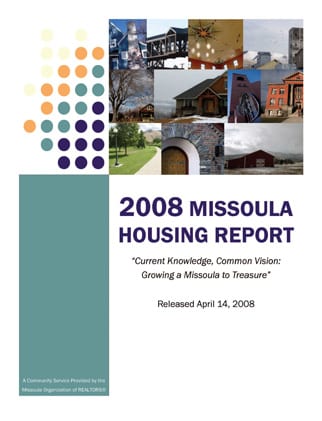 For 2007, data related to the Missoula housing market reveal two indications that are of greatest importance:
For 2007, data related to the Missoula housing market reveal two indications that are of greatest importance:
1. Some data indicate a softer real estate market – data such as that for number of homes sold, median sales price of homes, and building permits issued.
2. Missoulians’ income growth remains strongly positive and unemployment continues to trend downward. Yet, despite this “good news,” the “bad news” about housing in recent years is truer than ever: more Missoula families are finding their incomes insufficient to own or rent modest homes and apartments, and many more families are paying an overly large share of their incomes for housing – threatening their financial well-being.
Regarding a possible softening of the local market, signals – in the form of the data presented in this report – are highly mixed. That makes it very difficult to come up with reliable answers to critical questions regarding the future: Is the Missoula real estate market headed for a “delayed” downturn on the scale that much of the rest of the US is already experiencing? Or is the data of 2007 the weakest that Missoula will see, because our market’s continuing strengths will save it from the worst effects seen elsewhere?
We will likely be able to answer those questions with considerably more confidence toward the end of 2008. However, a look at events nationally would strongly suggest that home prices in Missoula would, at a minimum, soften further in the current year. In “The State of the Nation’s Housing 2007,” the Joint Center for Housing Studies of Harvard University observes that –
Home sales and starts usually head down before prices. Declining sales, and the inventory overhang left in their wake, increase the length of time homes are on the market as well as buyers’ resistance to higher prices. Eventually motivated sellers – like home builders and investors with unoccupied homes for sale – reduce their prices.
To the extent that decreasing sales of homes and increasing days on market are reliable indicators of price declines to come, we may see lower sale prices in our market for 2008 and perhaps into 2009.
Answers are not likely to come so soon, or so readily, concerning the relentless advance of home and rental prices at paces that exceed the ability of most Missoulians’ incomes to keep up. More worrisome still is that this inability to keep up is occurring while economic times have been relatively good. We may collectively shudder to think what might happen if income gains diminish and unemployment increases.
In this case, too, as with home prices, indicators at the national level are ominous. “The State of the Nation’s Housing” reports that, “In just one year, the number of households with housing cost burdens in excess of 30% of income climbed by 2.3 million, hitting a record 37.3 million in 2005.” Crossing the 30% threshold greatly imperils family finances, as “severely cost-burdened households in the bottom quartile [of household spending] had just $436 a month left to cover all other needs [but housing] in 2005.”
Yet, we would assert that the Missoula market has at least two significant advantages working in our favor. The first is quite practical: If any downturn we may experience lags the national market, we have more time to find solutions. The second is less tangible, but we’d hope no less real: We are resilient people with the blessing of a diverse economy.
To capitalize on these and any other advantages we may enjoy, we must understand that increased housing costs are triggered not only by price hikes in materials and labor, but also in a wide variety of other inputs, such as infrastructure (public and private utilities) and government fees and permits. As such, the challenge to keep home prices and rents within reach of working families with average or below average incomes is a challenge that requires a cooperative, community-wide response.
Builders, developers, real estate brokers, business owners, and leaders in government and nonprofit organizations all recognize the importance of having a workforce that lives in the community and are focusing on making that happen.